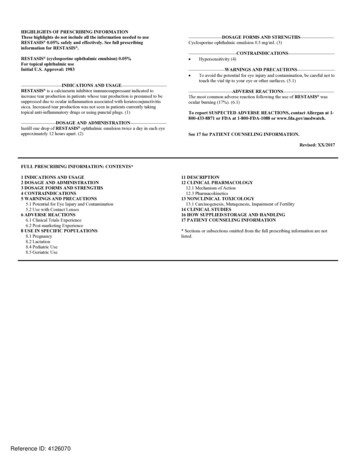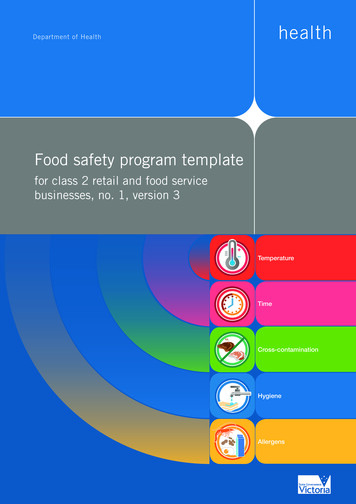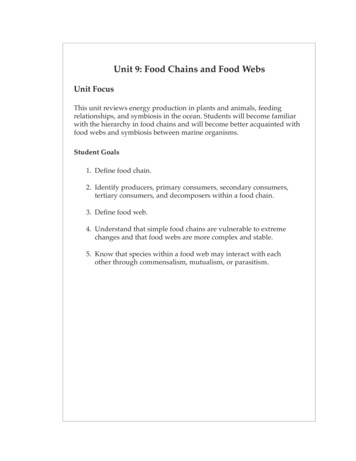
Transcription
HIGHLIGHTS OF PRESCRIBING INFORMATIONThese highlights do not include all the information needed to useRESTASIS 0.05% safely and effectively. See full prescribinginformation for RESTASIS .DOSAGE FORMS AND STRENGTHSCyclosporine ophthalmic emulsion 0.5 mg/mL (3)CONTRAINDICATIONSRESTASIS (cyclosporine ophthalmic emulsion) 0.05%For topical ophthalmic useInitial U.S. Approval: 1983 INDICATIONS AND USAGERESTASIS is a calcineurin inhibitor immunosuppressant indicated toincrease tear production in patients whose tear production is presumed to besuppressed due to ocular inflammation associated with keratoconjunctivitissicca. Increased tear production was not seen in patients currently takingtopical anti-inflammatory drugs or using punctal plugs. (1)DOSAGE AND ADMINISTRATIONInstill one drop of RESTASIS ophthalmic emulsion twice a day in each eyeapproximately 12 hours apart. (2)WARNINGS AND PRECAUTIONSTo avoid the potential for eye injury and contamination, be careful not totouch the vial tip to your eye or other surfaces. (5.1) Hypersensitivity (4)ADVERSE REACTIONSThe most common adverse reaction following the use of RESTASIS wasocular burning (17%). (6.1)To report SUSPECTED ADVERSE REACTIONS, contact Allergan at 1 800-433-8871 or FDA at 1-800-FDA-1088 or www.fda.gov/medwatch.See 17 for PATIENT COUNSELING INFORMATION.Revised: XX/2017FULL PRESCRIBING INFORMATION: CONTENTS*1 INDICATIONS AND USAGE2 DOSAGE AND ADMINISTRATION3 DOSAGE FORMS AND STRENGTHS4 CONTRAINDICATIONS5 WARNINGS AND PRECAUTIONS5.1 Potential for Eye Injury and Contamination5.2 Use with Contact Lenses6 ADVERSE REACTIONS6.1 Clinical Trials Experience6.2 Post-marketing Experience8 USE IN SPECIFIC POPULATIONS8.1 Pregnancy8.2 Lactation8.4 Pediatric Use8.5 Geriatric UseReference ID: 412607011 DESCRIPTION12 CLINICAL PHARMACOLOGY12.1 Mechanism of Action12.3 Pharmacokinetics13 NONCLINICAL TOXICOLOGY13.1 Carcinogenesis, Mutagenesis, Impairment of Fertility14 CLINICAL STUDIES16 HOW SUPPLIED/STORAGE AND HANDLING17 PATIENT COUNSELING INFORMATION* Sections or subsections omitted from the full prescribing information are notlisted.
FULL PRESCRIBING INFORMATION1INDICATIONS AND USAGERESTASIS ophthalmic emulsion is indicated to increase tear production in patients whose tear production ispresumed to be suppressed due to ocular inflammation associated with keratoconjunctivitis sicca. Increased tearproduction was not seen in patients currently taking topical anti-inflammatory drugs or using punctal plugs.2DOSAGE AND ADMINISTRATIONInvert the unit dose vial a few times to obtain a uniform, white, opaque emulsion before using. Instill one dropof RESTASIS ophthalmic emulsion twice a day in each eye approximately 12 hours apart. RESTASIS canbe used concomitantly with lubricant eye drops, allowing a 15-minute interval between products. Discard vialimmediately after use.3DOSAGE FORMS AND STRENGTHSOphthalmic emulsion containing cyclosporine 0.5 mg/mL4CONTRAINDICATIONSRESTASIS is contraindicated in patients with known or suspected hypersensitivity to any of the ingredients inthe formulation.5WARNINGS AND PRECAUTIONS5.1Potential for Eye Injury and ContaminationBe careful not to touch the vial tip to your eye or other surfaces to avoid potential for eye injury andcontamination.5.2Use with Contact LensesRESTASIS should not be administered while wearing contact lenses. Patients with decreased tear productiontypically should not wear contact lenses. If contact lenses are worn, they should be removed prior to theadministration of the emulsion. Lenses may be reinserted 15 minutes following administration of RESTASIS ophthalmic emulsion.6ADVERSE REACTIONSThe following serious adverse reactions are described elsewhere in the labeling: Potential for Eye Injury and Contamination [see Warnings and Precautions (5.1)]6.1Clinical Trials ExperienceBecause clinical trials are conducted under widely varying conditions, adverse reaction rates observed in theclinical trials of a drug cannot be directly compared to rates in the clinical trials of another drug and may notreflect the rates observed in practice.In clinical trials, the most common adverse reaction following the use of RESTASIS was ocular burning(17%).Other reactions reported in 1% to 5% of patients included conjunctival hyperemia, discharge, epiphora, eyepain, foreign body sensation, pruritus, stinging, and visual disturbance (most often blurring).Reference ID: 4126070
6.2Post-marketing ExperienceThe following adverse reactions have been identified during post approval use of RESTASIS . Because thesereactions are reported voluntarily from a population of uncertain size, it is not always possible to reliablyestimate their frequency or establish a causal relationship to drug exposure.Reported reactions have included: hypersensitivity (including eye swelling, urticaria, rare cases of severeangioedema, face swelling, tongue swelling, pharyngeal edema, and dyspnea); and superficial injury of the eye(from the vial tip touching the eye during administration).8USE IN SPECIFIC POPULATIONS8.1PregnancyRisk SummaryClinical administration of cyclosporine ophthalmic emulsion 0.05% is not detected systemically followingtopical ocular administration [see Clinical Pharmacology (12.3)], and maternal use is not expected to result infetal exposure to the drug. Oral administration of cyclosporine to pregnant rats or rabbits did not produceteratogenicity at clinically relevant doses [see Data].DataAnimal DataAt maternally toxic doses (30 mg/kg/day in rats and 100 mg/kg/day in rabbits), cyclosporine oral solution(USP) was teratogenic as indicated by increased pre- and postnatal mortality, reduced fetal weight and skeletalretardations. These doses (normalized to body surface area) are 5,000 and 32,000 times greater, respectively,than the daily recommended human dose of one drop (approximately 28 mcL) of cyclosporine ophthalmicemulsion 0.05% twice daily into each eye of a 60 kg person (0.001 mg/kg/day), assuming that the entire dose isabsorbed. No evidence of embryofetal toxicity was observed in rats or rabbits receiving cyclosporine duringorganogenesis at oral doses up to 17 mg/kg/day or 30 mg/kg/day, respectively. These doses in rats and rabbitsare approximately 3,000 and 10,000 times greater, respectively, than the daily recommended human dose.An oral dose of 45 mg/kg/day cyclosporine administered to rats from Day 15 of pregnancy until Day 21postpartum produced maternal toxicity and an increase in postnatal mortality in offspring. This dose is 7,000times greater than the daily recommended human dose. No adverse effects in dams or offspring were observedat oral doses up to 15 mg/kg/day (2,000 times greater than the daily recommended human dose).8.2LactationRisk SummaryCyclosporine is known to appear in human milk following systemic administration, but its presence in humanmilk following topical treatment has not been investigated. Although blood concentrations are undetectablefollowing topical administration of RESTASIS ophthalmic emulsion [see Clinical Pharmacology (12.3)],caution should be exercised when RESTASIS is administered to a nursing woman. The developmental andhealth benefits of breastfeeding should be considered along with the mother’s clinical need for RESTASIS andany potential adverse effects on the breast-fed child from cyclosporine.8.4Pediatric UseSafety and efficacy have not been established in pediatric patients below the age of 16.8.5Geriatric UseNo overall difference in safety or effectiveness has been observed between elderly and younger patients.Reference ID: 4126070
11DESCRIPTIONRESTASIS (cyclosporine ophthalmic emulsion) 0.05% contains a topical calcineurin inhibitorimmunosuppressant with anti-inflammatory effects. Cyclosporine’s chemical name is Cyclo[[(E)-(2S,3R,4R)-3 yl cyl-N-methyl-L-leucyl-N-methyl-L-valyl] and it has thefollowing structure:Structural FormulaFormula: C62H111N11O12Mol. Wt.: 1202.6Cyclosporine is a fine white powder. RESTASIS appears as a white opaque to slightly translucenthomogeneous emulsion. It has an osmolality of 230 to 320 mOsmol/kg and a pH of 6.5-8.0. Each mL ofRESTASIS ophthalmic emulsion contains: Active: cyclosporine 0.05%. Inactives: glycerin; castor oil;polysorbate 80; carbomer copolymer type A; purified water; and sodium hydroxide to adjust pH.12CLINICAL PHARMACOLOGY12.1Mechanism of ActionCyclosporine is an immunosuppressive agent when administered systemically.In patients whose tear production is presumed to be suppressed due to ocular inflammation associated withkeratoconjunctivitis sicca, cyclosporine emulsion is thought to act as a partial immunomodulator. The exactmechanism of action is not known.12.3PharmacokineticsBlood cyclosporine A concentrations were measured using a specific high pressure liquid chromatography-massspectrometry assay. Blood concentrations of cyclosporine, in all the samples collected, after topicaladministration of RESTASIS 0.05%, twice daily, in humans for up to 12 months, were below the quantitationlimit of 0.1 ng/mL. There was no detectable drug accumulation in blood during 12 months of treatment withRESTASIS ophthalmic emulsion.13NONCLINICAL TOXICOLOGY13.1Carcinogenesis, Mutagenesis, Impairment of FertilityCarcinogenesisSystemic carcinogenicity studies were conducted in male and female mice and rats. In the 78-week oral (diet)mouse study, at doses of 1, 4, and 16 mg/kg/day, evidence of a statistically significant trend was found forlymphocytic lymphomas in females, and the incidence of hepatocellular carcinomas in mid-dose malessignificantly exceeded the control value.Reference ID: 4126070
In the 24-month oral (diet) rat study, conducted at 0.5, 2, and 8 mg/kg/day, pancreatic islet cell adenomassignificantly exceeded the control rate in the low dose level. The hepatocellular carcinomas and pancreatic isletcell adenomas were not dose related. The low doses in mice and rats are approximately 80 times greater(normalized to body surface area) than the daily recommended human dose of one drop (approximately 28mcL) of 0.05% RESTASIS twice daily into each eye of a 60 kg person (0.001 mg/kg/day), assuming that theentire dose is absorbed.MutagenesisCyclosporine has not been found to be mutagenic/genotoxic in the Ames Test, the V79-HGPRT Test, themicronucleus test in mice and Chinese hamsters, the chromosome-aberration tests in Chinese hamster bonemarrow, the mouse dominant lethal assay, and the DNA-repair test in sperm from treated mice. A studyanalyzing sister chromatid exchange (SCE) induction by cyclosporine using human lymphocytes in vitro gaveindication of a positive effect (i.e., induction of SCE).Impairment of FertilityNo impairment in fertility was demonstrated in studies in male and female rats receiving oral doses ofcyclosporine up to 15 mg/kg/day (approximately 2,000 times the human daily dose of 0.001 mg/kg/daynormalized to body surface area) for 9 weeks (male) and 2 weeks (female) prior to mating.14CLINICAL STUDIESFour multicenter, randomized, adequate and well-controlled clinical studies were performed in approximately1,200 patients with moderate to severe keratoconjunctivitis sicca. RESTASIS demonstrated statisticallysignificant increases in Schirmer wetting of 10 mm versus vehicle at six months in patients whose tearproduction was presumed to be suppressed due to ocular inflammation. This effect was seen in approximately15% of RESTASIS ophthalmic emulsion-treated patients versus approximately 5% of vehicle-treated patients.Increased tear production was not seen in patients currently taking topical anti-inflammatory drugs or usingpunctal plugs.No increase in bacterial or fungal ocular infections was reported following administration of RESTASIS .16HOW SUPPLIED/STORAGE AND HANDLINGRESTASIS ophthalmic emulsion is packaged in sterile, preservative-free single-use vials. Each vial contains0.4 mL fill in a 0.9 mL LDPE vial; 30 or 60 vials are packaged in a polypropylene tray with an aluminumpeelable lid. The entire contents of each tray (30 vials or 60 vials) must be dispensed intact.30 Vials 0.4 mL each - NDC 0023-9163-3060 Vials 0.4 mL each - NDC 0023-9163-60Storage: Store at 15 -25 C (59 -77 F).17PATIENT COUNSELING INFORMATIONHandling the ContainerAdvise patients to not allow the tip of the vial to touch the eye or any surface, as this may contaminate theemulsion. Advise patients to not touch the vial tip to their eye to avoid the potential for injury to the eye [seeWarnings and Precautions (5.1)].Use with Contact LensesReference ID: 4126070
RESTASIS should not be administered while wearing contact lenses. Patients with decreased tear productiontypically should not wear contact lenses. Advise patients that if contact lenses are worn, they should be removedprior to the administration of the emulsion. Lenses may be reinserted 15 minutes following administration ofRESTASIS ophthalmic emulsion [see Warnings and Precautions (5.2)].AdministrationAdvise patients that the emulsion from one individual single-use vial is to be used immediately after openingfor administration to one or both eyes, and the remaining contents should be discarded immediately afteradministration. YYYY Allergan. All rights reserved.Irvine, CA 92612, U.S.A.All trademarks are the property of their respective owners.Patented. See www.allergan.com/patentsMade in the U.S.A.Reference ID: 4126070
HIGHLIGHTS OF PRESCRIBING INFORMATIONThese highlights do not include all the information needed to useRESTASIS MULTIDOSETM safely and effectively. See full prescribinginformation for RESTASIS MULTIDOSETM.RESTASIS MULTIDOSETM (cyclosporine ophthalmic emulsion) 0.05%For topical ophthalmic useInitial U.S. Approval: 1983INDICATIONS AND USAGERESTASIS MULTIDOSETM is a calcineurin inhibitor immunosuppressantindicated to increase tear production in patients whose tear production ispresumed to be suppressed due to ocular inflammation associated withkeratoconjunctivitis sicca. Increased tear production was not seen in patientscurrently taking topical anti-inflammatory drugs or using punctal plugs. (1)DOSAGE AND ADMINISTRATIONPrime by squeezing two drops onto a tissue before initial use. (2.1)Instill one drop of RESTASIS MULTIDOSETM ophthalmic emulsiontwice a day in each eye approximately 12 hours apart. (2.2) DOSAGE FORMS AND STRENGTHSCyclosporine ophthalmic emulsion 0.5 mg/mL (3)CONTRAINDICATIONS Hypersensitivity (4)WARNINGS AND PRECAUTIONSTo avoid the potential for eye injury and contamination, be careful not totouch the bottle tip to your eye or other surfaces. (5.1) ADVERSE REACTIONSThe most common adverse reaction following the use of cyclosporineophthalmic emulsion 0.05% was ocular burning (17%). (6.1)To report SUSPECTED ADVERSE REACTIONS, contact Allergan, Inc.at 1-800-433-8871 or FDA at 1-800-FDA-1088 or www.fda.gov/medwatch.See 17 for PATIENT COUNSELING INFORMATION and FDAapproved patient labeling.Revised: 10/2016FULL PRESCRIBING INFORMATION: CONTENTS*1 INDICATIONS AND USAGE2 DOSAGE AND ADMINISTRATION2.1 Preparation for First-Time Use2.2 Preparation for Use3 DOSAGE FORMS AND STRENGTHS4 CONTRAINDICATIONS5 WARNINGS AND PRECAUTIONS5.1 Potential for Eye Injury and Contamination5.2 Use with Contact Lenses6 ADVERSE REACTIONS6.1 Clinical Trials Experience6.2 Post-marketing Experience8 USE IN SPECIFIC POPULATIONS8.1 Pregnancy8.2 Lactation8.4 Pediatric Use8.5 Geriatric UseReference ID: 412607011 DESCRIPTION12 CLINICAL PHARMACOLOGY12.1 Mechanism of Action12.3 Pharmacokinetics13 NONCLINICAL TOXICOLOGY13.1 Carcinogenesis, Mutagenesis, Impairment of Fertility14 CLINICAL STUDIES16 HOW SUPPLIED/STORAGE AND HANDLING17 PATIENT COUNSELING INFORMATION* Sections or subsections omitted from the full prescribing informationare not listed.
FULL PRESCRIBING INFORMATION1INDICATIONS AND USAGERESTASIS MULTIDOSETM ophthalmic emulsion is indicated to increase tear production inpatients whose tear production is presumed to be suppressed due to ocular inflammationassociated with keratoconjunctivitis sicca. Increased tear production was not seen in patientscurrently taking topical anti-inflammatory drugs or using punctal plugs.2DOSAGE AND ADMINISTRATIONInstill one drop of RESTASIS MULTIDOSETM ophthalmic emulsion twice a day in each eyeapproximately 12 hours apart. RESTASIS MULTIDOSETM can be used concomitantly withlubricant eye drops, allowing a 15-minute interval between products.2.1Preparation for First-Time UseStep 1: Pull off the clear shipping cover by pulling straight up. Throw the shipping cover away.Do not use RESTASIS MULTIDOSETM if shipping cover or pull tab are damaged or missing.Step 2: Remove the pull tab on the olive green colored protective cap by pulling the end of thepull tab away from the bottle then winding it counterclockwise. Throw away the pull tab.Step 3: Remove the olive green colored protective cap by pulling it straight up. Keep the coloredprotective cap.Step 4: Prime the bottle for first-time use by squeezing two drops onto a tissue. Do not let thebottle tip touch the tissue.Reference ID: 4126070
Step 5: The bottle is now ready for use. After use, recap the bottle with the olive green coloredprotective cap by pushing it straight down onto the bottle.2.2Preparation for UseStep 6: Turn the bottle upside down a few times before giving your dose to make sure themedicine is mixed well.Step 7: Instill one drop in the affected eye. Replace the olive green colored protective cap.3DOSAGE FORMS AND STRENGTHSOphthalmic emulsion containing cyclosporine 0.5 mg/mL4CONTRAINDICATIONSRESTASIS MULTIDOSETM is contraindicated in patients with known or suspectedhypersensitivity to any of the ingredients in the formulation [see Adverse Reactions (6.2)].5WARNINGS AND PRECAUTIONS5.1Potential for Eye Injury and ContaminationBe careful not to touch the bottle tip to your eye or other surfaces to avoid potential for eyeinjury and contamination.5.2Uses with Contact LensesRESTASIS MULTIDOSETM should not be administered while wearing contact lenses. Patientswith decreased tear production typically should not wear contact lenses. If contact lenses areworn, they should be removed prior to the administration of the emulsion. Lenses may bereinserted 15 minutes following administration of RESTASIS MULTIDOSETM ophthalmicemulsion.6ADVERSE REACTIONSThe following serious adverse reactions are described elsewhere in the labeling: Potential for Eye Injury and Contamination [see Warnings and Precautions (5.1)]Reference ID: 4126070
6.1Clinical Trials ExperienceBecause clinical trials are conducted under widely varying conditions, adverse reaction ratesobserved in the clinical trials of a drug cannot be directly compared to rates in the clinical trialsof another drug and may not reflect the rates observed in practice.In clinical trials, the most common adverse reaction following the use of cyclosporineophthalmic emulsion, 0.05% was ocular burning (17%).Other reactions reported in 1% to 5% of patients included conjunctival hyperemia, discharge,epiphora, eye pain, foreign body sensation, pruritus, stinging, and visual disturbance (most oftenblurring).6.2Post-marketing ExperienceThe following adverse reactions have been identified during post approval use of cyclosporineophthalmic emulsion, 0.05%. Because these reactions are reported voluntarily from a populationof uncertain size, it is not always possible to reliably estimate their frequency or establish acausal relationship to drug exposure.Reported reactions have included: hypersensitivity (including eye swelling, urticaria, rare casesof severe angioedema, face swelling, tongue swelling, pharyngeal edema, and dyspnea); andsuperficial injury of the eye (from the bottle tip touching the eye during administration).8USE IN SPECIFIC POPULATIONS8.1PregnancyRisk SummaryClinical administration of cyclosporine ophthalmic emulsion 0.05% is not detected systemicallyfollowing topical ocular administration [see Clinical Pharmacology (12.3)], and maternal use isnot expected to result in fetal exposure to the drug. Oral administration of cyclosporine topregnant rats or rabbits did not produce teratogenicity at clinically relevant doses [see Data].DataAnimal DataAt maternally toxic doses (30 mg/kg/day in rats and 100 mg/kg/day in rabbits), cyclosporine oralsolution (USP) was teratogenic as indicated by increased pre- and postnatal mortality, reducedfetal weight and skeletal retardations. These doses (normalized to body surface area) are 5,000and 32,000 times greater, respectively, than the daily recommended human dose of one drop(approximately 28 mcL) of cyclosporine ophthalmic emulsion 0.05% twice daily into each eyeof a 60 kg person (0.001 mg/kg/day), assuming that the entire dose is absorbed. No evidence ofembryofetal toxicity was observed in rats or rabbits receiving cyclosporine during organogenesisat oral doses up to 17 mg/kg/day or 30 mg/kg/day, respectively. These doses in rats and rabbitsare approximately 3,000 and 10,000 times greater, respectively, than the daily recommendedhuman dose.An oral dose of 45 mg/kg/day cyclosporine administered to rats from Day 15 of pregnancy untilDay 21 postpartum produced maternal toxicity and an increase in postnatal mortality inoffspring. This dose is 7,000 times greater than the daily recommended human dose. No adverseeffects in dams or offspring were observed at oral doses up to 15 mg/kg/day (2,000 times greaterthan the daily recommended human dose).Reference ID: 4126070
8.2LactationRisk SummaryCyclosporine is known to appear in human milk following systemic administration, but itspresence in human milk following topical treatment has not been investigated. Although bloodconcentrations are undetectable following topical administration of cyclosporine ophthalmicemulsion 0.05% [see Clinical Pharmacology (12.3)], caution should be exercised whenRESTASIS MULTIDOSETM is administered to a nursing woman. The developmental and healthbenefits of breastfeeding should be considered along with the mother’s clinical need forRESTASIS MULTIDOSETM and any potential adverse effects on the breast-fed child fromcyclosporine.8.4Pediatric UseSafety and efficacy have not been established in pediatric patients below the age of 16.8.5Geriatric UseNo overall difference in safety or effectiveness has been observed between elderly and youngerpatients.11DESCRIPTIONRESTASIS MULTIDOSETM (cyclosporine ophthalmic emulsion) 0.05% contains a calcineurininhibitor immunosuppressant with anti-inflammatory effects. Cyclosporine’s chemical name ylamino)-6-octenoyl]-L-2-aminobutyryl-N leucyl-L-alanyl-D-alanyl-N-methyl-L leucyl-N-methyl-L-leucyl-N-methyl-L-valyl] and it has the following structure:Structural FormulaFormula: C62H111N11O12Mol. Wt.: 1202.6Cyclosporine is a fine white powder. RESTASIS MULTIDOSETM appears as a white opaque toslightly translucent homogeneous emulsion. It has an osmolality of 230 to 320 mOsmol/kg and apH of 6.5-8.0. Each mL of RESTASIS MULTIDOSETM ophthalmic emulsion contains: Active:cyclosporine 0.05%. Inactives: glycerin; castor oil; polysorbate 80; carbomer copolymer type A;purified water; and sodium hydroxide to adjust pH.12CLINICAL PHARMACOLOGY12.1Mechanism of ActionCyclosporine is an immunosuppressive agent when administered systemically.Reference ID: 4126070
In patients whose tear production is presumed to be suppressed due to ocular inflammationassociated with keratoconjunctivitis sicca, cyclosporine emulsion is thought to act as a partialimmunomodulator. The exact mechanism of action is not known.12.3PharmacokineticsBlood cyclosporine A concentrations were measured using a specific high pressure liquidchromatography-mass spectrometry assay. Blood concentrations of cyclosporine, in all thesamples collected, after topical administration of cyclosporine ophthalmic emulsion, 0.05%,twice daily, in humans for up to 12 months, were below the quantitation limit of 0.1 ng/mL.There was no detectable drug accumulation in blood during 12 months of treatment withcyclosporine ophthalmic emulsion, 0.05%.13 NONCLINICAL TOXICOLOGY13.1Carcinogenesis, Mutagenesis, Impairment of FertilityCarcinogenesisSystemic carcinogenicity studies were conducted in male and female mice and rats. In the 78 week oral (diet) mouse study, at doses of 1, 4, and 16 mg/kg/day, evidence of a statisticallysignificant trend was found for lymphocytic lymphomas in females, and the incidence ofhepatocellular carcinomas in mid-dose males significantly exceeded the control value.In the 24-month oral (diet) rat study, conducted at 0.5, 2, and 8 mg/kg/day, pancreatic islet celladenomas significantly exceeded the control rate in the low dose level. The hepatocellularcarcinomas and pancreatic islet cell adenomas were not dose related. The low doses in mice andrats are approximately 80 times greater (normalized to body surface area) than the dailyrecommended human dose of one drop (approximately 28 mcL) of cyclosporine ophthalmicemulsion, 0.05% twice daily into each eye of a 60 kg person (0.001 mg/kg/day), assuming thatthe entire dose is absorbed.MutagenesisCyclosporine has not been found to be mutagenic/genotoxic in the Ames Test, the V79-HGPRTTest, the micronucleus test in mice and Chinese hamsters, the chromosome-aberration tests inChinese hamster bone-marrow, the mouse dominant lethal assay, and the DNA-repair test insperm from treated mice. A study analyzing sister chromatid exchange (SCE) induction bycyclosporine using human lymphocytes in vitro gave indication of a positive effect (i.e.,induction of SCE).Impairment of FertilityNo impairment in fertility was demonstrated in studies in male and female rats receiving oraldoses of cyclosporine up to 15 mg/kg/day (approximately 2,000 times the human daily dose of0.001 mg/kg/day normalized to body surface area) for 9 weeks (male) and 2 weeks (female) priorto mating.14CLINICAL STUDIESFour multicenter, randomized, adequate and well-controlled clinical studies were performed inapproximately 1,200 patients with moderate to severe keratoconjunctivitis sicca. Cyclosporineophthalmic emulsion, 0.05% demonstrated statistically significant increases in Schirmer wettingof 10 mm versus vehicle at six months in patients whose tear production was presumed to besuppressed due to ocular inflammation. This effect was seen in approximately 15% ofReference ID: 4126070
cyclosporine ophthalmic emulsion, 0.05%-treated patients versus approximately 5% of vehicletreated patients. Increased tear production was not seen in patients currently taking topical antiinflammatory drugs or using punctal plugs.No increase in bacterial or fungal ocular infections was reported following administration ofcyclosporine ophthalmic emulsion, 0.05%.16HOW SUPPLIED/STORAGE AND HANDLINGRESTASIS MULTIDOSETM ophthalmic emulsion is packaged in a sterile, multi-dosepreservative-free bottle. Each bottle consists of a white opaque LDPE bottle, a white opaquepolypropylene top with unidirectional valve and air filter, a protective olive green polypropylenecap, and a clear disposable shipping cover over the colored cap.5.5 mL in 10-mL bottle - NDC 0023-9163-05Storage: Store at 15-25 C (59-77 F).17PATIENT COUNSELING INFORMATIONHandling the ContainerAdvise patients to not allow the tip of the bottle to touch the eye or any surface, as this maycontaminate the emulsion. Advise patients to not touch the bottle tip to their eye to avoid thepotential for injury to the eye [see Warnings and Precautions (5.1)].Use with Contact LensesRESTASIS MULTIDOSETM should not be administered while wearing contact lenses. Patientswith decreased tear production typically should not wear contact lenses. Advise patients that ifcontact lenses are worn, they should be removed prior to the administration of the emulsion.Lenses may be reinserted 15 minutes following administration of RESTASIS MULTIDOSETMophthalmic emulsion [see Warnings and Precautions (5.2)].AdministrationAdvise patients to read the “Instructions for Use” for detailed first-time use instructions. 2016 Allergan. All rights reserved.Irvine, CA 92612, U.S.A.All trademarks are the property of their respective owners.Patented: See: www.allergan.com/products/patentsMade in Ireland.Reference ID: 4126070
INSTRUCTIONS FOR USERESTASIS MULTIDOSETM (Re stay’ sis Mul tee dōs)(cyclosporine ophthalmic emulsion) 0.05%Read this Instructions for Use before you start using RESTASIS MULTIDOSETM and each time you get arefill. There may be new information. This leaflet does not take the place of talking to your healthcareprovider about your medical condition or treatment.Important: RESTASIS MULTIDOSETM is for use in the eyeWash your hands before using RESTASIS MULTIDOSETM.Do not let the bottle tip touch the eye or any other surfaces to avoid contamination or injury to youreye.Use 1 drop of RESTASIS MULTIDOSETM in each eye, 2 times each day, about 12 hours apart.If you wear contact lenses, remove them before using RESTASIS MULTIDOSETM. Wait for at least15 minutes before placing them back in your eyes.RESTASIS MULTIDOSETM can be used with lubricant eye drops, but you should wait at least 15minutes between using each product.Parts of your RESTASIS MULTIDOSETM bottlezPREPARING THE BOTTLE FOR FIRST-TIME USE:Step 1: Pull off shipping cover by pulling straight up. Throwthe shipping cover away. Do not use RESTASISMULTIDOSETM if shipping cover or pull tab are damaged ormissing.Step 2: Remove the pull tab on the olive green coloredprotective cap by pulling the end of the pull tab away from thebottle then winding it counterclockwise. Throw away the pulltab.Step 3: Remove the olive green colored protective cap bypulling it straight up. Keep the colored protective cap.Step 4: Prime the bottle for first tim
5.1 Potential for Eye Injury and Contamination . Be careful not to touch the vial tip to your eye or other surfaces to avoid potential for eye injury and contamination. 5.2 . Use with Contact Lenses RESTASIS should not be administered while wearing contact lenses. Patients with decreased tear production typically should not wear contact lenses.










